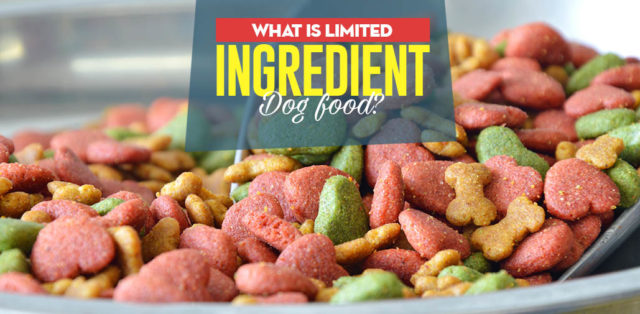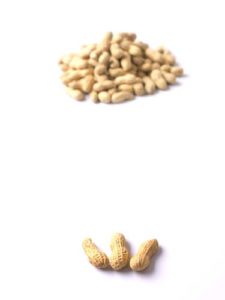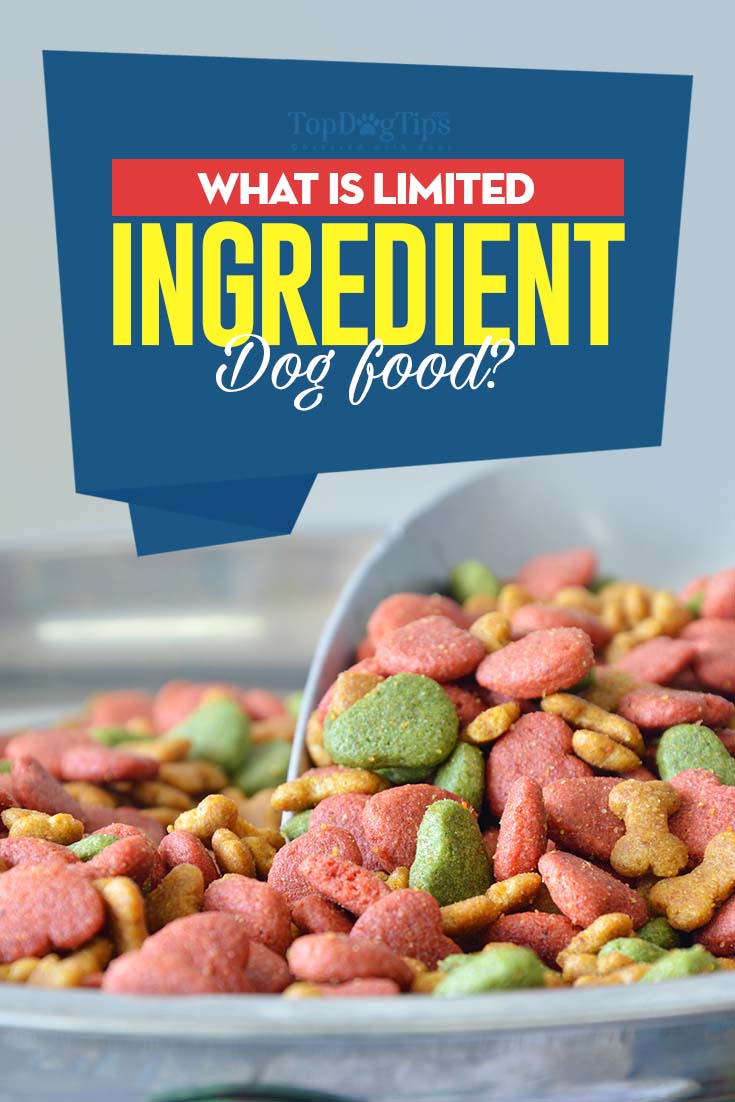
There are many “labels” of dog food types, and limited ingredient dog food is just one of the many dog food options.
But how do you know if it’s the right choice for your dog?
Today, we’re taking a look at what makes limited ingredient dog food different from other types, formulas, and recipes, and how you can tell if it’s the right fit for your dog’s needs.
Table of Contents
- What is Limited Ingredient Dog Food?
- Common Allergens and Better Ingredient Choices
- Are There Guidelines for Classifying a Food as Limited Ingredient Dog Food?
- What Makes a Good Limited Ingredient Dog Food?
- But Does Your Dog Need Limited Ingredient Dog Food?
- Can Your Dog Eat Limited Ingredient Dog Food Even If They Don’t Have Allergies?
What is Limited Ingredient Dog Food?
Limited ingredient dog food is a pet food formula made with fewer ingredients and usually better quality ingredients when compared to more traditional dog foods (read: popular and often cheaper).
The food itself is also manufactured a little differently, and this manufacturing process reduces the likelihood of reactions in allergy-prone dogs.
How is Limited Ingredient Dog Food Different?
While there is no official definition, several factors would classify a pet food formula as a “limited ingredient dog food” brand.
Those are:
- Amount of filler
- Number of ingredients
- Protein sources
- Number of protein sources
Let's take a closer look at each of these and what exactly they mean.
Less Filler
 Almost all popular commercial dog foods include some ingredients with little nutritional value.
Almost all popular commercial dog foods include some ingredients with little nutritional value.
They are often colloquially referred to as “filler” ingredients or “fillers.”
Some really bad dog foods will have many of these useless ingredients.
Fillers may include things like cottonseed hulls, rice bran, corn bran, wheat mill run, rice hulls, straw, modified corn starch, and peanut hulls (to name a few).
These ingredients are added to increase or “bulk up” the amount of food a large corporation can produce while keeping its costs low.
While pet owners may complain about this, this makes most commercial foods affordable for consumers because most companies pass the savings on to the buyer (at least to some extent).
This is why premium dog food is also much more expensive, as explained by nutritionist Dr. Jennifer Adolphe, Ph.D.
Unfortunately, while they do save us some money, filler ingredients are also more likely to cause undesirable reactions in dogs, particularly related to allergy concerns.
This is why limited-ingredient dog food was invented, and it's made without “filler” ingredients.
Fewer Ingredients Overall
As with filler content, many big-name corporations include ingredients that are not necessary for their food.
This may also be done to increase the amount of food, but these ingredients do have some nutritive value or provide “appeal” to the food (unlike filler ingredients).
However, their purpose is still to dilute the cost of manufacturing.
The problem is that adding more “junk” ingredients to food increases the likelihood that a dog prone to allergies will experience an allergic reaction.
Limited ingredient dog foods are made with as few ingredients as possible to limit possible allergens and only prioritize the most essential ingredients in their recipes.
Better Quality
Many cheap commercial dog foods are also made using less expensive ingredients, which are more likely to cause allergies in dogs.
For example, low-quality ingredients like by-product meals and other rendered animal products are not for human consumption (they are considered inedible waste), yet they are frequently used in cheaper dog foods.
 Why? Because they’re cheap and they still provide protein content.
Why? Because they’re cheap and they still provide protein content.
Some pet food companies will argue that things like meat meals contain more protein and are nutritious (which is true), but the real reason is that they cut the cost of manufacturing pet foods and allow us to buy dog food at lower prices.
However, even if meat meals and other types of byproducts are indeed nutritious, the real problem is that there's no way for pet owners to know the source of these meat meals, which can be anything, including dead or diseased animals.
They can also be from sources more likely to cause digestive upset or allergic reactions in dogs.
Limited ingredient dog food brands are made using higher quality proteins and better cuts of meat from those protein sources.
Companies manufacturing this line of dog food will usually try to maintain a better reputation for their limited-ingredient dog food recipes.
Single Source Proteins
Using multiple proteins in dog foods is another way commercial dog food companies cut their cost.
For example, bison is a desirable protein, but it’s more expensive than more traditional protein sources.
So, a company can claim bison in their food but also dilute their cost by incorporating cheaper proteins like chicken.
While multiple proteins cut the manufacturing cost for companies and the purchase price for you, they also increase the possibility of allergens in the food.
Studies have found that some of the commonly used protein sources in dog food, such as beef and chicken, are most likely to cause allergic reactions in dogs.
Limited-ingredient dog food is almost always made using a single protein source.
This allows pet owners of allergy-prone dogs to easily select a dog food brand that does not contain their dog’s allergen or find out which foods are the cause of allergic reactions.
Rarer Protein Sources
Dogs with allergies and sensitivities to foods are more likely to have allergies to ingredients that are overused and overproduced.
For example, chicken is something companies include in the majority of their products and something that is produced en masse in our culture.
This pattern of overuse and mass production leads to shortcuts that lower the quality of food products and increase the likelihood of allergic reactions in dogs.
Many limited-ingredient dog food brands contain less common protein sources to avoid the likelihood of allergic reactions.
They are often referred to as novel proteins, and studies have found these to be the least likely to trigger symptoms of food allergies in dogs.
Common Allergens and Better Ingredient Choices
As I've said above, some foods and ingredients are more likely to cause allergies in dogs.
Therefore, these ingredients are the first to be eliminated from limited-ingredient diets.
The now eliminated ingredients are replaced with more hypoallergenic ingredients or suitable alternative ingredients.
Those aren't always novel/rare protein sources but simply something that may suit your particular dog better.
For example, a beef allergy formula may use chicken as a protein source.
Look at the chart below to get an idea of what these foods are:
| Common Allergens | Less Likely to Aggravate Allergies | |||||
| Corn | Wheat | Sweet potatoes | Rutabagas | Lamb | Elk | Venison |
| Chicken | Beef | White Fish | Squash | Bison | Buffalo | Moose |
| Egg | Soy | Oats/Oatmeal | Barley | Ostrich | Emu | Kangaroo |
| Dairy | Green Beans | Lentils | Horse | Rabbit | Goat | |
Are There Guidelines for Classifying a Food as Limited Ingredient Dog Food?
No, there is no specific guidelines that allow companies to label their foods as being officially recognized as “limited ingredient dog food.”
In short, food can meet one or all of the points above and still be labeled as limited-ingredient food.
That said, most reputable pet food companies will try to maintain a good reputation and follow the above-mentioned guidelines.
All you have to do when picking a limited-ingredient dog food brand is check the ingredients list and make sure everything fits, and it's rare that it doesn't.
But let's discuss this in more detail.
ALSO READ: The Best Hypoallergenic Dog Foods for Dogs with Allergies
What Makes a Good Limited Ingredient Dog Food?
If there are no guidelines or regulatory boards monitoring the labeling of limited-ingredient dog foods, how can a pet owner know what makes a good limited-ingredient dog food brand and that it's safe to buy?
AAFCO Regulations
Although there are no “limited ingredient” labeling regulations, there are nutrition regulations that dog food manufacturers must abide by.
These regulations determine how a dog's food is labeled for feeding.
For example, if a dog food formula is labeled for supplementary feeding only, then it's not a “good” dog food choice that can be relied upon to provide your pets with the necessary nutrients they need to thrive.
All “good” limited-ingredient dog food brands will be labeled by the AAFCO for “all life stages” or — even better — for specific life stages that are suitable for your dog and referred to as “complete” or “balanced” (this is because “all life stages” label in itself is questionable).
Quantity and Quality of Ingredients
 Fewer ingredients are the primary reason why limited ingredient dog food exists; however, the quality of those ingredients should still be considered and sometimes prioritized over the number of ingredients.
Fewer ingredients are the primary reason why limited ingredient dog food exists; however, the quality of those ingredients should still be considered and sometimes prioritized over the number of ingredients.
For example, if you were to compare two limited-ingredient dog food brands — one with five ingredients and one with seven ingredients — you may be tempted to think the food with five ingredients was a better choice. Not so fast.
If you look at the ingredients list, you may see that the five-ingredient dog food package contains three filler ingredients and is not labeled as “complete” or “balanced.”
You may then see that the seven-ingredient dog food contains all whole foods and is labeled as “complete” or “balanced.”
In this instance, the better of the two choices has more ingredients but provides better nutrition.
Place of Packaging and Brand Reputation
The place of manufacturing/packaging of any dog food brand is another consideration that remains the same regardless of the type of food you are buying.
Pet food manufacturing laws and regulations differ from country to country.
If a limited ingredient dog food is manufactured in a plant in Thailand or China, for example, you should keep in mind that quality control in those countries is not the same as quality control in the USA or Europe (and this is why).
Apart from checking the reputation of packaging and manufacturing plants, you should always check the reputation of the food brand as well.
If you were interested in buying food made by Earthborn (made by Midwestern Pet Food company), you would see that they have had no recalls in the past at the time of this writing.
The no-recall history bodes well for you and your pet. But again, not so fast.
Say you were interested in buying food made by Artemis, for example, and you see that while Artemis has never had their dog food recalled, their manufacturing is done by Diamond Pet Foods, and their food is made alongside Evangers Foods.
Both Diamond and Evangers have had recalls in the past.
All of this matters and paints a good picture for you to make a better choice with picking dog food.
Preferably, you should always choose a limited-ingredient dog food that is made in the U.S. and packaged in the U.S. by a company with few to no recalls in the past.
There are several companies that are notorious for having a large amount of dog food recalls, but as the article explains, that also doesn't always mean all of their foods should be avoided.
Source of Ingredients
 Just like the location of manufacturing matters, the source of the ingredients in your dog’s food is also an important consideration.
Just like the location of manufacturing matters, the source of the ingredients in your dog’s food is also an important consideration.
For example, a company may say that its food is manufactured and packaged in the U.S., but its ingredients may be sourced from China. That's a major problem.
Now, it’s not necessary to have all of your ingredients sourced in the U.S.
And it's not essential that a company manufactures their dog food in the same location as where their ingredients are coming from, too.
Take a lamb, for instance – it is very often sourced in New Zealand.
What you need to do, however, is separate the countries with good quality control procedures from those with bad quality control procedures.
So, a food using New Zealand lamb or Canadian beef would be perfectly acceptable, but a food using Chinese corn gluten would not.
This is why I created lists like top dog food brands and top puppy food brands, where I've gone through not only specific food ingredient lists but also the company's reputation, recall history, and other data to pinpoint which ones are least likely to be harmful to our dogs.
But Does Your Dog Need Limited Ingredient Dog Food?
It's likely that your dog doesn't need it, but there's a way for you to assess for this.
Studies show that, on average, only 10% (or fewer) of dogs will experience food-related allergies and sensitivities.
This seems like a low number, but recent panic over the detriment of certain ingredients like grains has led to pet owners falsely believing that their dogs are allergic to those ingredients.
So, what can you do if you can’t assume your dog has an allergy?
Watch for Symptoms
 The first thing that you need to do is watch for symptoms of food allergies or intolerance in your dog.
The first thing that you need to do is watch for symptoms of food allergies or intolerance in your dog.
For more details, read some actual science-based expert articles from veterinarians on how to diagnose food allergies in dogs (this, this, and this are accurate and expert-written articles about food allergies in dogs).
Briefly, symptoms of dog food allergies you should look out for include:
- Regular diarrhea
- Obvious discomfort after eating (bloated belly, crying, inability to find a comfortable place to rest; be sure not to confuse this with canine bloat)
- Vomiting regularly after eating
- Dry and flaking skin
- Constant scratching (when another skin condition is not present)
- Chewing feet
- Recurrent ear infections
- Hair loss
- Skin infections
- Unusual skin odor (usually due to skin infections/yeast)
If your dog is showing none of these signs and no other signs of discomfort or poor health during or after eating, your pooch is likely fine with the ingredients in his current dog food brand, and there's no reason to change it.
If you do notice some of the symptoms mentioned above, you will need to pinpoint what it is that your dog is allergic to or sensitive to.
There are two methods of doing this: (1) allergy testing and (2) the elimination diet. Let's briefly cover this.
Allergy Testing
Any veterinarian can perform allergy testing on your dog, and it’s the fastest and most accurate method of determining what allergies your Fido has and whether they should be switched to limited-ingredient dog food.
Talk to your vet about the symptoms you have seen in your dog and ask them to conduct allergy testing.
There are several types of dog allergy tests, and they are priced similarly.
Intradermal testing for allergens (or skin testing) will cost around $200. This method involves sedating your dog and pricking their skin to introduce allergens, then watching for a reaction on the skin.
Blood testing (or serum IgE testing) ranges from $200 to $300. This involves taking a sample of your dog’s blood to test for allergen reactions in a laboratory setting.
Most pet owners opt for intradermal testing because it is the most reliable form of allergy testing.
For elderly pets and pets with compromised immune systems, however, blood testing is preferred since it is minimally invasive and does not require sedation.
There are “at home” allergen test kits for dogs (like this one), and they cost just above $100.
However, these are much less reliable, and some may even say a useless waste of money. It's better to test your dog at the vet for a few extra dollars.
The Elimination Diet
Another method of identifying your dog’s allergens is the elimination diet, which can be done at home all by yourself. This will involve several phases, but it's fairly simple.
During the first phase of this diet, select a small bag of very limited ingredient dog food that contains protein and carbohydrates that your dog has never or rarely been exposed to (for example, bison and sweet potatoes).
Be sure to read the ingredient list thoroughly to make sure none of the “big allergens” are included in the food in any way. Start feeding your dog this food.
Generally, it is recommended to always gradually transition your dog into new foods over the course of 7-10 days.
However, if your dog is exhibiting severe allergy symptoms, then it may be best to jump directly into the new food.
After a week or two of feeding your dog this limited-ingredient dog food diet, you should notice an improvement in your pet's health.
If you do not see any improvements, consider a different novel protein source, perhaps ostrich, and repeat the test again.
If you notice a change in your dog’s health after switching them to a limited-ingredient dog food formula, you can keep them on this new food but slowly (one at a time) add small amounts of new ingredients.
This will help you to track specifically which ingredient your dog is having trouble with.
The unfortunate thing about the elimination diet is that it takes a while to complete, and it can get quite costly in the end.
The hit-and-miss nature of this treatment plan is also very frustrating for dogs and their owners because there are so many possible allergens it can be hard to identify the offending one (unless you get lucky in the very beginning).
Can Your Dog Eat Limited Ingredient Dog Food Even If They Don’t Have Allergies?
Yes, absolutely.
A dog doesn’t have to have allergies in order to eat a limited-ingredient dog food brand.
In fact, many pet parents choose limited-ingredient dog foods to eliminate unnecessary fillers and keep their dog’s diet as clean as possible with fewer ingredients.
If you do feed your dogs a limited-ingredient dog food diet and they don’t have allergies, it’s best to rotate through foods in the same line.
This provides protein diversity and reduces the chance of your dog experiencing sensitivities to foods in the future.
READ NEXT: 4 Dangerous Ingredients (According to Studies) Commonly Used in Dog Foods













